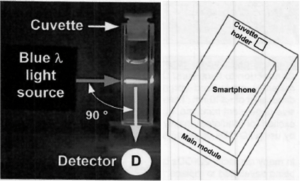Summary
Detecting heavy metals in water is essential to ensure clean drinking water and appropriate regulatory decisions following an accident (e.g., a spill) or an emergency. Traditionally, high-sensitivity detection of heavy metals requires bulky and costly (to purchase and operate) lab-based instruments. We propose developing a palm-sized, element-specific, highly-sensitive, battery-operated, smartphone-controlled system for on-site measurement to provide timely heavy metal concentration information. Two-dimensional quantum dots (2D-QDs) will be modified by adding molecular components specific to a heavy metal of interest; the interaction between the heavy metal and the chosen molecular component will result in visible fluorescence that can be measured. A high-sensitivity instrument will be developed around a battery-operated, portable microplasma, which will serve as a light source, and a battery-operated photo-detector. For measurement, modified 2D-QDs will be added to a contaminated water sample inside a cuvette placed in the instrument. When excited by the light emitted by the microplasma, the resultant fluorescence will indicate the presence and concentration of heavy metals in the water sample. Further, data acquisition electronics will be embedded in the instrument and a smartphone can be used to receive the digital data wirelessly. The development of this sensor can significantly improve the monitoring of heavy metals in waters in Canada and worldwide.

Figure 1. (Left) A concept diagram of the proposed instrumentation consisting of the light source, a cuvette with a water sample and a detector. (Right) The proposed fluorescence-measurement system will be palm-sized, battery operated and controlled by a smartphone.
Related Content

Two-Dimensional Quantum Materials and Heterostructures
Two-dimensional (2D) layers just one atom thick can be stripped from certain materials, such as graphene.
June 1, 2017

Tuning Spin-Exchange Interactions in Low-Dimensional Metal Halide Perovskites: A New Class of Semiconductor Quantum Materials
Summary Leakage current in electronic components is one of the limiting factors for the performance of conventional computers which use charges and currents as physical information carriers. Spintronics offers an alternative by using electron spin for information transfer, processing and storage, enabling the design of non-volatile computer memory and more energy-efficient electronic devices. In this […]
October 1, 2019

Next Generation Quantum Sensors
We are developing new semiconductor p-n junctions and designing novel nanowire arrays that have the potential to significantly enhance the ability to detect light at the single photon level over an unprecedented wavelength range from the ultraviolet to infrared.
June 1, 2017

Scanning Tunneling Microscopy of Quantum Materials, Devices and Molecules
Summary This project advances our ability to characterize and study novel quantum materials, quantum devices, and even individual molecules at the atomic level. By combining Non-Contact Atomic Force Microscopy (NC-AFM), Scanning Tunneling Microscopy (STM) and scanning gate methods, we correlate spatial information with transport properties and can locally manipulate charge, spin and structural states. […]
January 28, 2019

